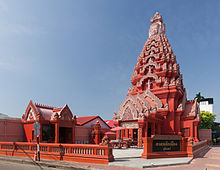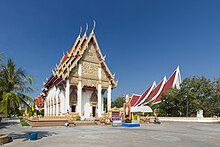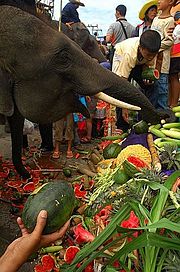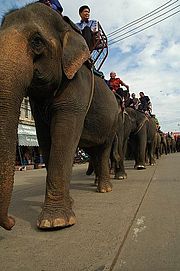- For other places with the same name, see Surin (disambiguation).
Surin (สุรินทร์) is a town in Isaan, Thailand. Surin is a quiet, nondescript, town. Its claim to fame is its annual Elephant Roundup, which takes place in November (book a room in advance). Surin's people have had a long relationship with elephants and they have become the provincial icon, epitomizing as they do raw power coupled with intelligence and strong kinship values. Plenty of Khmer ruins, beautiful silk fabrics, and highly-prized jasmine rice also make Surin a destination worth a visit.

Understand
[edit]Surin is the capital of Surin Province. Its population is small, approximately 40,000, but the province is densely populated. It lies about 450 km east of Bangkok and 50 km from the Cambodian border.
History
[edit]Surin's story dates back thousands of year when the Suay or Kuay ethnic groups migrated along the Mekong River to settle around the Dongrek Range. Kuay ethnic people, found in Thailand and Laos, are talented in catching and training elephants. Some 2,000 years ago, during the Khmer Era, the town of Surin was established. After the fall of the Khmer Empire, the town was neglected until 1763, when Luang Surin Pakdi (Chiang Poom), headman of Muang Tee Village, led his people to settle at Ban Khu Prakai, now the town of Surin. He later became the first mayor of the settlement.
Get in
[edit]By car
[edit]From Bangkok, Surin is just over a six hour drive. Head north via Hwy 1 (Pahonyothin Rd) and get onto Hwy 2 (Mittraphap Rd) at Saraburi. Use Hwy 24 (Chok Chai-Det Udom) via Nang Rong, Prasat, then turn left onto Hwy 214 to Surin. This route is 457 km long. Or at Korat, motorists can change to Hwy 226, via Chakkrarat , Huai Thalaeng, Lam Plai Mat, Buriram to Surin. This route is 434 km in length.
By bus
[edit]- Bangkok's northeastern Bus terminal (Mo Chit 2) on Kamphaeng Phet 2 Rd has daily services to Surin. For more information, call ☏ +66 2 9362852-66 Transport Co, Surin Branch ☏ +66 44 511756. Kitchakan Ratchasima Tour Co, ☏ +66 44 512161, Nakhon Chai Air Co., ☏ +66 44 515151.
- Minibuses (60 baht) connect the town with Chong Chom, which hosts a border crossing with O'Smach in Cambodia.
By train
[edit]Trains regularly leave Bangkok's Hualamphong and Bang Sue stations for Surin. Ordinary trains take 8.5 hours to make the journey. For more information, call 1690, ☏ +66 2 2204334, ☏ +66 2 2204444. Surin Railway Station ☏ +66 44 511295, ☏ +66 44 515393 or visit State Railway of Thailand[dead link].
Get around
[edit]Surin is a small, so most journeys in the central area can be made on foot. However, there are also samlors (rickshaws) and tuk-tuks. The larger hotels have cars available for hire. Keep in mind that no one considers overcharging a foreigner to be a serious crime. A samlor ride around the central region of the town is 40 baht, a tuk-tuk maybe 50-60 baht for foreigners. If in doubt ask your hotel for advice. When getting off the bus always be extra careful not to be taken for a ride while being taken for a ride.
See
[edit]

- Elephant Study Centre (Surin Elephant Village), Moo 2 Surin-Roi Et Road Tha Tum (Tha Tum, about 60 km from Surin). 8:30-16:30 daily. In Ban Ta Klang. These villagers are descendants of the Suay or Kuay ethnic group, who have a long history of elephant husbandry. Unlike northern Thailand where elephants are kept for labour, Ta Klang people consider elephants as their friends who can share the same house. There are however some ethical questions about how the elephants are ridden and chained for their cultural shows. THB 100.
- Surin National Museum (พิพิธภัณฑสถานแห่งชาติ สุรินทร์) (About 4 km S of the city on Rte 214. There is nothing to see along the road, and given the speed of cars and the lack of a sidewalk, walking is not recommended. The pink songthaew from city will take you to the museum for 10 baht, or use a tuk-tuk/samlor). The Surin National Museum was established in 1974. It was first housed in the Surin City Hall, but was later moved to the Surin Education Office. In 1992 the Thai Fine Arts Department proposed a dedicated museum building for the province. Construction of the museum began in 1995, and was completed in 2010. The museum is now in Ban Nongtao, Chaniang sub-district, Mueang district, on Hwy 214. The museum covers five topics: natural science, history-archaeology, local history, ethnology, and local heritage.
- City Pillar Shrine (ศาลหลักเมืองสุรินทร์). The Lak Mueang shrine is the sacred icon, the tutelary deity of the city and the province. Prior to 1968 the shrine did not house a pillar. This changed in 1968 when the Thai Fine Arts Department designed a new city shrine. A city pillar for this new shrine was made from a golden cassia log.
- Lower Isaan Art and Crafts Centre (ศูนย์ศิลปาชีพอีสานใต้) (on a bypass road, close to Tambon Nok Mueang Administration organization, SE of Surin City). The centre displays art and cultural exhibits of lower Isaan.
- The Monument of Phaya Surin Phakdi Si Narong Changwang (Pum) (อนุสาวรีย์พระยาสุรินทรภักดีศรีณรงค์จางวาง (ปุม)). This is a statue of Surin's traditional founder and first mayor, Phaya Surin. The black, brass statue is 2.2 metres high, and was dedicated in 1968. The statue is at the southern entrance to the city, at what is now a major traffic round-about, but was in the past the inner wall of the city. Pum stands on a high plinth, and is depicted holding a curve-bladed pike in right hand. This is a traditional device used to control an elephant. The pike reflects his legendary skill in controlling war elephants, and recognises the important of the role of elephants in both the history and economy of Surin.
- Wat Burapharam (วัดบูรพาราม). Ancient Buddhist temple built by Surin's first mayor Phaya Surin Phakdi Si Narong Changwang. The wat houses a Buddha image of Luang Pho Phra Chi, which was built at the same time as the temple.
- Ban Buthom Basketry Village หมู่บ้านจักสานบ้านบุทม. The village is famed for its rattan basketry. The basketry is a major complement to the income the village derives from agriculture. A notable feature of the basketry is that the villages do not paint lacquer on the finished product, which may cause the growth of fungus, but soak their basketry with lemon, carambola, or kaffir lime to make it glossy.
- Village of Chansoma Golden Brocade, Ban Tha Sawang หมู่บ้านทอผ้าไหมยกทองจันทร์โสมา บ้านท่าสว่าง. The village is highly recognised for its 1,416-heddled, gold-brocaded silk, being offered to the queen. The outstanding performance of the village is that it was selected by the government to weave cloth for the shirts of 21 APEC leaders and the shawls of their spouses.
- Khwao Sinarin Handicrafts Village หมู่บ้านหัตถกรรมเขวาสินรินทร์. The community is famed for local-style silk cloth called "hol" which is considered the best silk fabric. Ban Chok village is the first village to produce silver buttons called "luk pa kueam" which is used as decorations for ladies.
- Wat Burapharam (วัดบูรพาราม), Moo 1 Chit Bamrung Rd, ☏ +66 4451 4447. This ancient Buddhist temple was built by Surin's first mayor Phaya Surin Phakdi Si Narong Changwang. The wat houses a Buddha image of Luang Pho Phra Chi, which was built at the same time as the temple.
- Huai Saneng ห้วยเสนง. Huai Saneng Reservoir has a high and steep crest. Its southern area has a rich display of water lilies and flocks of birds. The palace of Mother Princess is at the headquarters of Phanom Sawai Forest Park. วนอุทยานพนมสวาย. The park has a hill with three peaks. The first peak, Yot Khao Chai, or the Man Peak, is where Wat Phanom Sawai is found. The second peak, Yot Khao Ying, or the Lady Peak, houses a medium-size Buddha image. The third peak, Yot Khao Kok, houses an octagon pavilion.
- Huai Thap Than - Huay Samran Wildlife Sanctuary เขตรักษาพันธ์สัตว์ป่าห้วยทับทัน-ห้วยสำราญ. This is a lush area of jungle on the Thai-Cambodia border. The sanctuary has an education centre for the public. From October to December, wild flowers are in full bloom.
- Pa Son Nong Khu Forest Park วนอุทยานป่าสนหนองคู. There is a clue showing that this area used to be very abundant forest in the past. There are Pinus mergusii grown all over the area, mixed with the dry deciduous dipterocarp forest. It is home only to small animals: squirrels, Malayan flying lemurs, wild rabbits, snakes, doves, coucals, and myna. Hornbills have been seen on occasion.
Khmer-era temples
[edit]These stretch from the border westwards to Buriram Province. There are few organised tours (tourism is not overly big in Isaan). You can always find an (expensive) rental car, with driver, at your hotel, or it is possible to visit the major temples by using the local public transport system (this is very cheap). Ask you hotel or guesthouse for instructions. (Most signs at the bus and train stations are in Thai, however, the staff are very helpful.)
- 1 Prasat Sikhoraphum. A set of temple ruins in a quiet surroundings.
- Prasat Ta Meuan. A complex of three structures built in the 12th–13th centuries around the time of the Cambodian king Jayavarman VII. The largest building is Prasat Ta Meuan Thom. It is surrounded by an outer wall, and contains a large central rectangular building on a north-south axis. To the south is Prasat Ta Meuan Toht, a smaller structure, with an outer wall. The last and smallest of three is Prasat Ta Meuan, a small building with no wall, approximately 15 m x 5 m. All of these buildings show signs of disrepair and looting. A return journey by taxi to the complex will cost you ~2,000 baht. There are occasional excursion buses, when there is sufficient interest. Check with your hotel or travel agent. There is no on-site English language assistance, nor much information about the complex. There may still be unexploded land mines from the days of the Khmer Rouge. Stay on the paths and do not wander into the surrounding jungle. Free.




- Mueang Thi Khmer Ruins (ปราสาทเมืองที), Moo 1 Mueang Surin. Built from brick and cement, these Khmer ruins included five stupas on a base, with the largest in the middle and the rest at four corners. One stupa at the corner has completely damaged.
- Ban Phlai Khmer Ruins (ปราสาทบ้านไพล). Three brick stupas in the same line are surrounded with moat except on the east. Although Shiva Linga and some lintels are missing, the remaining artifacts are kept at Phimai National Museum indicate that the Khmer ruins were built in the 11th century.
- Baan Phluang Khmer Ruins (ปราสาทหินบ้านพลวง). A small sanctuary, but with excellent stone carving. Facing east, the single stupa stands on large rectangular laterite base. The main door is real, while other three are false doors. The stupa is built from laterite, sandstone, and brick.
- Ta Muean Group of Khmer Ruins กลุ่มปราสาทตาเมือน. The Khmer ruins includes three stupas in the same area.
- Ta Muean Khmer Ruins ปราสาทตาเมือน. The sanctuary in Bayon Art style is built from laterite, like other architectures of King Chaya Varaman VII found in Thailand. A few Buddha images in the attitude of meditation in the niche are found here.
- Ta Muean Tot Khmer Ruins ปราสาทตาเมือนโต๊ด. The sanctuary includes a principal stupa, made from laterite and sandstone, in a square shape with front balcony. Like other Khmer hospital's shrines, there is a pond outside the wall.
- Ta Muean Thom Khmer Ruins ปราสาทตาเมือนธม. The biggest sanctuary in the group includes three stupas with the biggest at the mid and smaller ones on each side.
- Prasat Si Khoraphum ปราสาทศีขรภูมิ. This Khmer-era prasat consists of five prang on a laterite base, all facing east. The main and largest prang is in the centre, with the four, smaller prang at each corner. All are built from sandstone and laterite. The lintel depicting Dances of Shiva is considered the most beautiful one among those found in Thailand and Cambodia. Three sides of the prasat are surrounded by a moat.
- Tapiang Tia Khmer Ruins ปราสาทตะเปียงเตีย. The rectangular stupa was constructed from bricks, and has five lotus-shaped peaks. The stupa is in the Laotian-style, which dates it to the late Ayutthaya period (Tapiang Tia translates as duck pond).
- Phum Pon Khmer Ruins ปราสาทภูมิโปน. The Khmer ruin includes four stupas, three made from bricks and one made from laterite. The biggest and the northern stupas are the oldest Khmer ruins found in Thailand, around the 8th century.
- Yai Ngao Khmer Ruins (ปราสาทยายเหงา), Sangkha, ☏ +66 4451 4447. This Khmer ruin consists of two stupas facing east, and standing in a north-south direction. The brick stupas stand on a laterite base and are decorated with carved brick gable, which depict the mythical creature, a makorn. The makorn is a legendary animal, a chimera composed of parts from a lion, an elephant, and a fish, and holding five-headed naga in its mouth.
- Chom Phra Khmer Ruins (ปราสาทจอมพระ), ☏ +66 4451 4447. Like the majority of shrines at Khmer hospitals, it comprises square-shaped stupa with balcony and a library at front. Significant relics found include a head of Bodhisattva Avalokitesavara statue and statue of Vajrasattva.
Do
[edit]Festivals
[edit]- Ordination parade on elephant's back (งานประเพณีบวชนาคแห่ช้าง), Wat Chaeng Sawang, Ban Ta Klang, Tha Tum District. This tradition is held mostly on the 13th-15th day of the waxing moon in May (around mid-May). Khmer, Laotian, and Suay people are all Buddhist and families wish their sons to enter monkhood and study the dhamma before marriage. The ordination of large numbers of monks simultaneously on elephant back over long distances confer great merit on the families of the ordainees. As all participants dress decoratively with mat-mi silk, the tradition earns lots of merit which is passed down through generations. The parade includes more than 50 elephants crossing the Mun River, with those ordained having shaved heads, all paying homage to Chao Pho Wang Thalu Shrine before starting the ordination.
- Surin Elephant Roundup and Surin Red Cross Fair (งานช้างและกาชาดสุรินทร์), Si Narong Stadium. Yearly, third weekend of November. A three day-long event where elephants roam the streets of Surin and perform in various activities: soccer, beauty contests, battle re-enactments, and the like.
- Surin Jasmine Rice and Silk Cloth Fair (งานวันข้าวหอมมะลิอินทรีย์และมหกรรมผ้าไหมสุรินทร์). Held every January, the Fair features contests of agricultural products, silk cloth, and presentations from governmental institutions.
- Thai Elephant Day (งานวันช้างไทย). A light and sound show which describes the legends of Thai elephants. Held annually in the second week of November.
- Ascending Phanom Sawai Mountain Festival (งานประเพณีขึ้นเขาพนมสวาย). This annual festival is a parade of traditional art and culture to Phanom Sawai mountain, in order to pay respect to Phra Yai, the intimate Buddha’s footprint, Luang Phu Dun, and Wat Phanom Silaram. This festival is held in March.

- Surin International Cultural Exchange.(formerly known as SIFF: Surin International Folklore Festival) เทศกาลการแสดงแลกเปลี่ยนศิลปวัฒนธรรมนานาชาติ (เดิมชื่อ เทศกาลการแสดงศิลปวัฒนธรรมพื้นบ้านนานาชาติ). Held every January by Surindra Rajabhat University. The festival features performances from many countries.
- Si Khoraphum Khmer Ruins Celebration and Loi Krathong งานฉลองปราสาทศีขรภูมิและงานประเพณีลอยกระทง. The annual celebration is held every third weekend of November at Si Khoraphum Khmer Ruins. The celebration features performance, lifestyle of ethnic people (Khmer, Lao, and Suay), local performances, souvenir market, beauty contest, krathong contest, and floats.
- Eel Festival เทศกาลงานปลาไหล. The fair is held at the field of Chumphon Buri District every third week of December, after the harvest, when eels are big enough to catch. Farmers normally can catch lots of eels at that time.
- Long Boat Racing Festival งานประเพณีชิงถ้วยพระราชทาน. Organized in October every year. Four types of racing for the royal trophy and the contest of boat beauty parade will be organized on Maenam Mun in front of Wat Pho, Tha Tum District.
Buy
[edit]- "Mai" Dried lotus seeds snack. A well-known Surin snack of made from lotus seeds. It has a soft sweet taste and is available everywhere. It has been listed as one of the Best 50 Gourmet Souvenirs from around the world by Condé Nast Traveller Magazine.
Eat
[edit]Surin has a fantastic night market. Be sure to try the Isaan sausage and Laos-style flattened chicken (gai yang), but be careful with the som tam (papaya salad). In addition to the night market Surin is liberally endowed with small restaurants, and the usual street vendors. Also the major hotels have reasonably priced menus.
Drink
[edit]Surin is not known for its many bars, but there are a few places offering drinks and nightlife. Most are located near the Thong Tarin Hotel. Adjacent to the hotel are two streets lined with small bars, restaurants, karaoke bars, and go-go bars. The larger hotels also have bars and restaurants. There are also several small restaurants managed or owned by expats scattered around town. The largest is the Farang Connection, followed by the Oasis, The Beach in Surin and N & N's German Restaurant, all near the bus station.
Sleep
[edit]- New Hotel, 6-8 Thanasan Rd, ☏ +66 44 511 341. Check-out: noon. Fan room with bath. 300 baht.
- 1 One Fu Hotel, Near IQ Modern Trade and merely a few kilometers with many important places such as Robinson shopping mall and other attractions, onefuhotel@gmail.com. Boutique, modern style hotel. 550+ baht.
- Petchaskem Hotel (500 m from the bus station). An older hotel.
- Pirom-Aree's Guest House, 55 326 Soi Arunee. Thung Poh Rd, ☏ +66 44 513 234. Check-out: noon. Fan rooms, outside bath 200 baht.
- Surin Majestic (Next to the bus station). The newest and best looking, but somewhat boring, hotel in Surin. Impeccably clean. Adjacent to the bus station, a big plus. Wi-Fi excellent on both the third floor and at the pool. 1,200+ baht with buffet breakfast.
- TK Mansions, 87 Krungsrinai, Muang District (Across the street from the Municipal Government Building), ☏ +66 92 26 312, +66 89 681 8150. T.K. Mansions is on the street where the Night Market is every evening. The building is new and it is connected to the latest fiber optic internet service in Thailand, which guarantees a good quality internet connection. A long-term stay is also possible. Just ask the manager, Mrs. Sue, who speaks English very well. 500 baht.
- Thong Tarin Hotel (About 500 m from the bus station). Clean, tidy, and happening, with the attached Rose Queen bath house, where a dirty (male) traveler can get clean. The hotel's large beer garden is in front of the hotel. Swimming pool, snooker club. 1,100+ baht.
Go next
[edit]- Buriram
- Cambodia is accessible via the Chong Chom/O'Smach border crossing. The drive into Cambodia becomes very scenic as the road descends the Dangrek Mountains. At the border, between the two countries' immigration offices, are a couple of casino hotels. Visas are issued at this border, make sure you only pay USD20 for a Cambodian tourist visa. Touts will try to convince you to pay more. On the Cambodian side, O'Smach town, a collection of attap huts and unpaved streets, is less than 1 km down the hill from the immigration offices. It has at least three guesthouses for those arriving late and not able to make onward travel. It also has a market with cafes and a branch of Acleda Bank (no ATM).
Paramount Angkor Transport runs buses to Samraong and beyond from O'Smach town. Look for the attap hut with bus advertisements on the highway at the turning to the town. On the Thai side, minibuses run from Chong Chom to Surin (60 baht).
| Routes through Surin |
| Bangkok ← Buriram ← | W |
→ Si Saket → Ubon Ratchathani |

